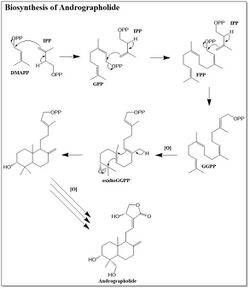Chemistry:Andrographolide

| |
| Names | |
|---|---|
| IUPAC name
3-[2-[Decahydro-6-hydroxy-5-(hydroxymethyl)-5,8a-dimethyl-2-methylene-1-napthalenyl]ethylidene]dihydro-4-hydroxy-2(3H)-furanone
| |
| Identifiers | |
3D model (JSmol)
|
|
| ChEBI | |
| ChEMBL | |
| ChemSpider | |
PubChem CID
|
|
| UNII | |
| |
| |
| Properties | |
| C20H30O5 | |
| Molar mass | 350.455 g·mol−1 |
| Appearance | Rhombic prisms or plates from ethanol or methanol |
| Density | 1.2317 g/cm3 |
| Melting point | 230 to 231 °C (446 to 448 °F; 503 to 504 K) |
| Sparingly soluble | |
| Related compounds | |
Related labdanes
|
14-deoxyandrographolide |
Related compounds
|
Xiyanping |
Except where otherwise noted, data are given for materials in their standard state (at 25 °C [77 °F], 100 kPa). | |
| Infobox references | |
Andrographolide is a labdane diterpenoid that has been isolated from the stem and leaves of Andrographis paniculata.[1] Andrographolide is an extremely bitter substance.
Andrographolide has been studied for its effects on cell signaling, immunomodulation, and stroke.[2] Study has shown that andrographolide may bind to a spectrum of protein targets including NF-κB and actin by covalent modification.[3][4]
Biosynthesis
While andrographolide is a relatively simple diterpene lactone, the biosynthesis by Andrographis paniculata was determined in the 2010s.[5][6] Andrographolide is a member of the isoprenoid family of natural products. The precursors to isoprenoid biosynthesis, isopentenyl pyrophosphate (IPP) and dimethylallyl pyrophosphate (DMAPP), can be synthesized through either the mevalonic acid pathway (MVA) or deoxyxylulose pathway (DXP).[7] Through selective C13 labeling of the precursors to both the MVA and DXP pathways, it was determined that the majority of the andrographolide precursors are synthesized through the DXP pathway.[7] There are a small portion of andrographolide precursors synthesized through the MVA pathway. The biosynthesis of andrographolide begins with the addition of IPP to DMAPP, which forms geranyl pyrophosphate. Another molecule of IPP is then added, yielding farnesyl pyrophosphate (FPP). The final IPP molecule is added to the FPP to complete the backbone of the diterpene. The double bond originating from DMAPP is oxidized to an epoxide prior to the ring closing cascade that forms two six-membered rings. A series of oxidations form a five-membered lactone in addition to adding on the alcohol groups. The order of these post-synthetic modifications is not entirely known.[7]
See also
- Xiyanping WINDOSE-Tablet
References
- ↑ "Andrographolide, the active constituent of Andrographis paniculata Nees; a preliminary communication". The Indian Medical Gazette 86 (3): 96–7. March 1951. PMID 14860885.
- ↑ abcamBiochemicals Andrographolide-ab120636
- ↑ "A quantitative chemical proteomics approach to profile the specific cellular targets of andrographolide, a promising anticancer agent that suppresses tumor metastasis". Molecular & Cellular Proteomics 13 (3): 876–86. March 2014. doi:10.1074/mcp.M113.029793. PMID 24445406.
- ↑ "Is there a future for andrographolide to be an anti-inflammatory drug? Deciphering its major mechanisms of action". Biochemical Pharmacology 139: 71–81. September 2017. doi:10.1016/j.bcp.2017.03.024. PMID 28377280.
- ↑ "Andrographis paniculata transcriptome provides molecular insights into tissue-specific accumulation of medicinal diterpenes". BMC Genomics 16 (1): 659. September 2015. doi:10.1186/s12864-015-1864-y. PMID 26328761.
- ↑ "Jasmonate-induced biosynthesis of andrographolide in Andrographis paniculata". Physiologia Plantarum 153 (2): 221–9. February 2015. doi:10.1111/ppl.12252. PMID 25104168.
- ↑ 7.0 7.1 7.2 "Biosynthesis of andrographolide in Andrographis paniculata". Phytochemistry 71 (11–12): 1298–304. August 2010. doi:10.1016/j.phytochem.2010.05.022. PMID 20557910. Bibcode: 2010PChem..71.1298S.
 |


